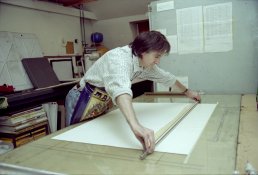holmburgers
Member
This printer was brought to my attention by Charles Berger. Attached (in 2 jpegs) is an article about Gerard Anière from the World Journal of Post-Factory Photography, 2004.
Mssr. Anière has developed a home-grown method to produce modern color-carbro prints.
In case the details of carbro are fuzzy, allow me to defuzz briefly. The process uses tissues that are identical (generally speaking) to carbon tissues, but the method of "exposure" is different. Instead of sensitizing in dichromates and exposing to UV light under a negative, a carbon tissue and a black & white bromide print (hence car-bro) are squeegeed into intimate contact in a solution of potassium dichromate, potassium ferricyanide, potassium bromide & chromic acid. This is a carbro bleach. This solution bleaches the bromide print and its byproducts migrate to and tan the gelatin of the pigment tissue. E. Howard Farmer discovered this property, and his name lends itself to what we know as Farmer's Reducer. The exposed carbro tissue is transfered and developed just like a carbon print.
The most cited obstacle to carbro is the unsuitable nature of most modern day b&w papers and their gelatin supercoat. To overcome this Gerard is using a home-made silver emulsion that appears to have been inspired by Jim Browning's dye-transfer emulsion. He coats this onto large sheets of clear polyester and these become his "bromides". Apparently his digital negatives are created by Tod Gangler in Seattle; Art & Soul. The beauty of carbro is that you don't need enlarged negatives, and this allows him to make very large carbro prints.
Anyways, there's much more in the article and a big thanks to Charles for sending me a picture of Gerard in action!
Mssr. Anière has developed a home-grown method to produce modern color-carbro prints.
In case the details of carbro are fuzzy, allow me to defuzz briefly. The process uses tissues that are identical (generally speaking) to carbon tissues, but the method of "exposure" is different. Instead of sensitizing in dichromates and exposing to UV light under a negative, a carbon tissue and a black & white bromide print (hence car-bro) are squeegeed into intimate contact in a solution of potassium dichromate, potassium ferricyanide, potassium bromide & chromic acid. This is a carbro bleach. This solution bleaches the bromide print and its byproducts migrate to and tan the gelatin of the pigment tissue. E. Howard Farmer discovered this property, and his name lends itself to what we know as Farmer's Reducer. The exposed carbro tissue is transfered and developed just like a carbon print.
The most cited obstacle to carbro is the unsuitable nature of most modern day b&w papers and their gelatin supercoat. To overcome this Gerard is using a home-made silver emulsion that appears to have been inspired by Jim Browning's dye-transfer emulsion. He coats this onto large sheets of clear polyester and these become his "bromides". Apparently his digital negatives are created by Tod Gangler in Seattle; Art & Soul. The beauty of carbro is that you don't need enlarged negatives, and this allows him to make very large carbro prints.
Anyways, there's much more in the article and a big thanks to Charles for sending me a picture of Gerard in action!








